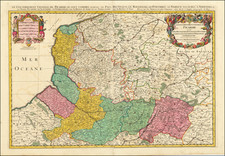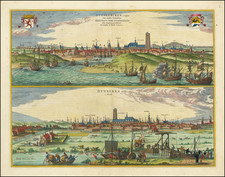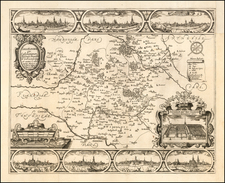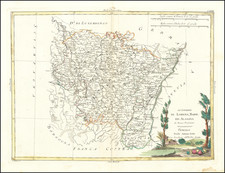Finely executed manuscript map showing a bombardment of French positions by the Dutch and English naval forces on August 27, 1695, off the coast of Calais.
The forces of the Dutch and English are shown offshore (A, B, C, D and E), with the positions of the defending French on land (F, G, H, I, L M, N) illustrating fortifications and defensive battery positions arrayed along the coast and most notably the main channel into the port.
The English were led by Admiral John Berkeley, 3rd Baron Berkeley of Stratton who led the British fleet on expeditions along the French Coast in 1694 and 1695, including unsuccessful attacks on Dunkirk and Calais in August 1695.
Nine Years War
The Nine Years' War (1688–1697), often called the War of the Grand Alliance or the War of the League of Augsburg was a conflict between France and a European coalition which mainly included the Holy Roman Empire (led by the Habsburg monarchy), the Dutch Republic, England, Spain, Savoy, Sweden and Portugal. Because the war included European colonies, it is sometimes considered the first world war.
The war took place during the Glorious Revolution in England, where William of Orange deposed King James VII and II and subsequently struggled against him for control of Scotland and Ireland, and a campaign in colonial North America between French and English settlers and their respective Native American allies.
In September 1688, King Louis XIV crossed the Rhine to pressure the Holy Roman Empire into accepting his territorial and dynastic claims. Leopold I, Holy Roman Emperor and German princes opposed Louis XIV with the States General of the Netherlands and William III of England joining the conflict against France, along with a growing list o European powers.
Most of the war was fought on France's borders in the Spanish Netherlands, the Rhineland, the Duchy of Savoy, and Catalonia. While the French were generally successful in battle, by 1696, France was in economic turmoil, as were the most of its opponents, resulting in the Peace of Ryswick, whereby Louis XIV retained the whole of Alsace but in exchange had to return Lorraine to its ruler and give up any gains on the right bank of the Rhine. Louis XIV also recognized William III as the rightful king of England, while the Dutch acquired a barrier fortress system in the Spanish Netherlands to help secure their borders.
The peace would be short-lived. with the Louis XIV and the Grand Alliance soon at war in the War of the Spanish Succession.









![[Calais] Chales](https://storage.googleapis.com/raremaps/img/small/61301sb.jpg)




